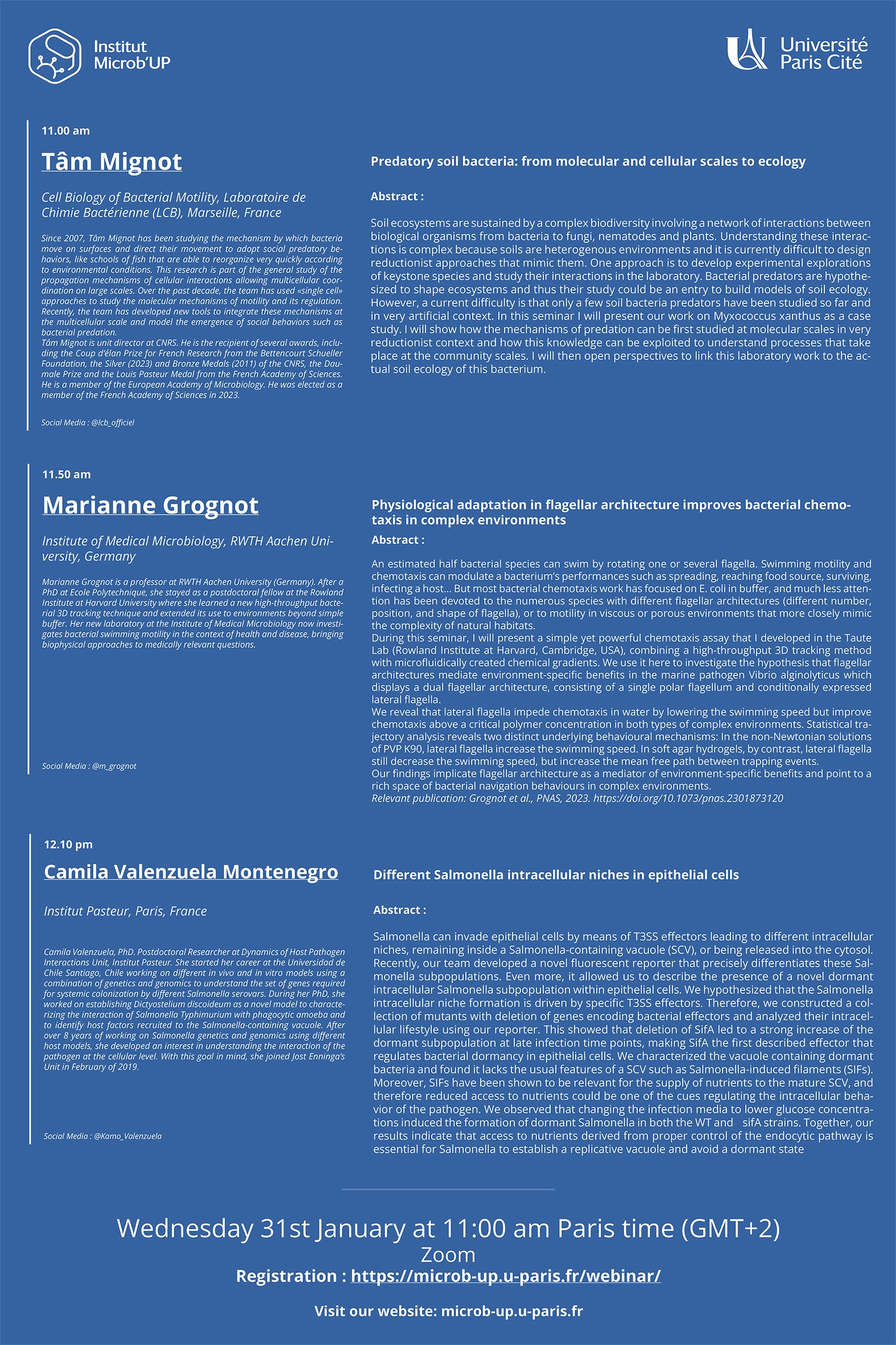
Host Laboratory : Mathieu Coureuil (http://www.posi-lab.fr/ ; INEM, Paris)
Soil ecosystems are sustained by a complex biodiversity involving a network of interactions between biological organisms from bacteria to fungi, nematodes and plants. Understanding these interactions is complex because soils are heterogenous environments and it is currently difficult to design reductionist approaches that mimic them. One approach is to develop experimental explorations of keystone species and study their interactions in the laboratory. Bacterial predators are hypothesized to shape ecosystems and thus their study could be an entry to build models of soil ecology. However, a current difficulty is that only a few soil bacteria predators have been studied so far and in very artificial context. In this seminar I will present our work on Myxococcus xanthus as a case study. I will show how the mechanisms of predation can be first studied at molecular scales in very reductionist context and how this knowledge can be exploited to understand processes that take place at the community scales. I will then open perspectives to link this laboratory work to the actual soil ecology of this bacterium.
An estimated half bacterial species can swim by rotating one or several flagella. Swimming motility and chemotaxis can modulate a bacterium’s performances such as spreading, reaching food source, surviving, infecting a host… But most bacterial chemotaxis work has focused on E. coli in buffer, and much less attention has been devoted to the numerous species with different flagellar architectures (different number, position, and shape of flagella), or to motility in viscous or porous environments that more closely mimic the complexity of natural habitats.
During this seminar, I will present a simple yet powerful chemotaxis assay that I developed in the Taute Lab (Rowland Institute at Harvard, Cambridge, USA), combining a high-throughput 3D tracking method with microfluidically created chemical gradients. We use it here to investigate the hypothesis that flagellar architectures mediate environment-specific benefits in the marine pathogen Vibrio alginolyticus which displays a dual flagellar architecture, consisting of a single polar flagellum and conditionally expressed lateral flagella.
We reveal that lateral flagella impede chemotaxis in water by lowering the swimming speed but improve chemotaxis above a critical polymer concentration in both types of complex environments. Statistical trajectory analysis reveals two distinct underlying behavioural mechanisms: In the non-Newtonian solutions of PVP K90, lateral flagella increase the swimming speed. In soft agar hydrogels, by contrast, lateral flagella still decrease the swimming speed, but increase the mean free path between trapping events.
Our findings implicate flagellar architecture as a mediator of environment-specific benefits and point to a rich space of bacterial navigation behaviours in complex environments.
Salmonella can invade epithelial cells by means of T3SS effectors leading to different intracellular niches, remaining inside a Salmonella-containing vacuole (SCV), or being released into the cytosol. Recently, our team developed a novel fluorescent reporter that precisely differentiates these Salmonella subpopulations. Even more, it allowed us to describe the presence of a novel dormant intracellular Salmonella subpopulation within epithelial cells. We hypothesized that the Salmonella intracellular niche formation is driven by specific T3SS effectors. Therefore, we constructed a collection of mutants with deletion of genes encoding bacterial effectors and analyzed their intracellular lifestyle using our reporter. This showed that deletion of SifA led to a strong increase of the dormant subpopulation at late infection time points, making SifA the first described effector that regulates bacterial dormancy in epithelial cells. We characterized the vacuole containing dormant bacteria and found it lacks the usual features of a SCV such as Salmonella-induced filaments (SIFs). Moreover, SIFs have been shown to be relevant for the supply of nutrients to the mature SCV, and therefore reduced access to nutrients could be one of the cues regulating the intracellular behavior of the pathogen. We observed that changing the infection media to lower glucose concentrations induced the formation of dormant Salmonella in both the WT and DsifA strains. Together, our results indicate that access to nutrients derived from proper control of the endocytic pathway is essential for Salmonella to establish a replicative vacuole and avoid a dormant state.
Download the fyer

